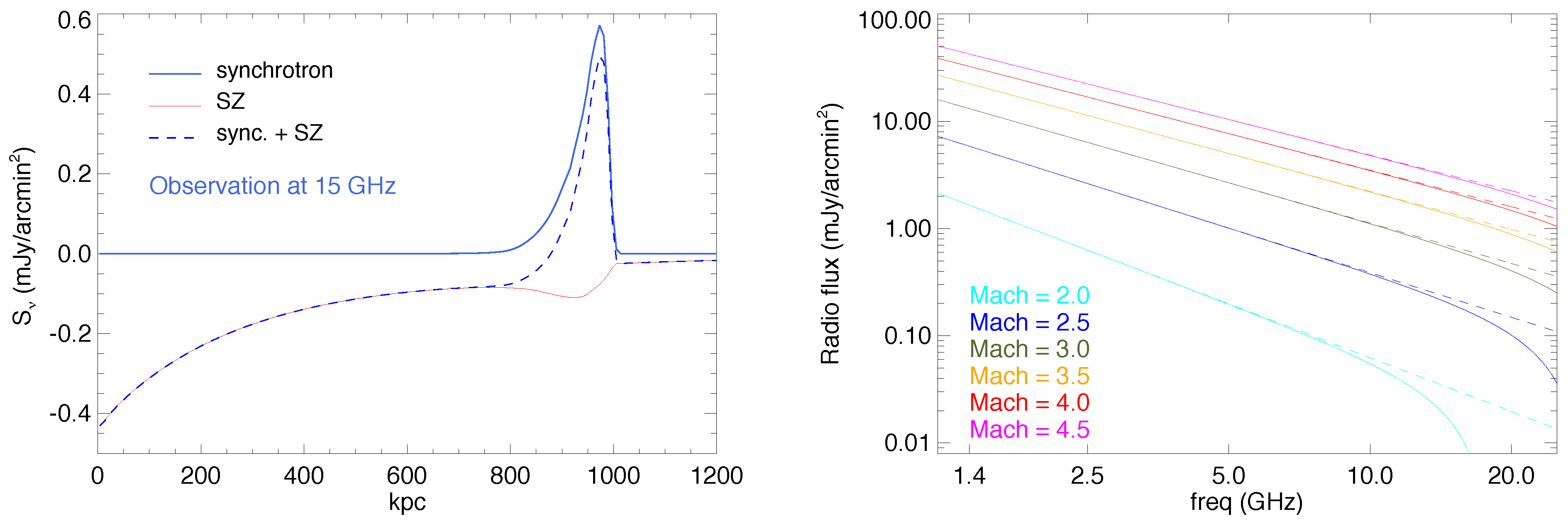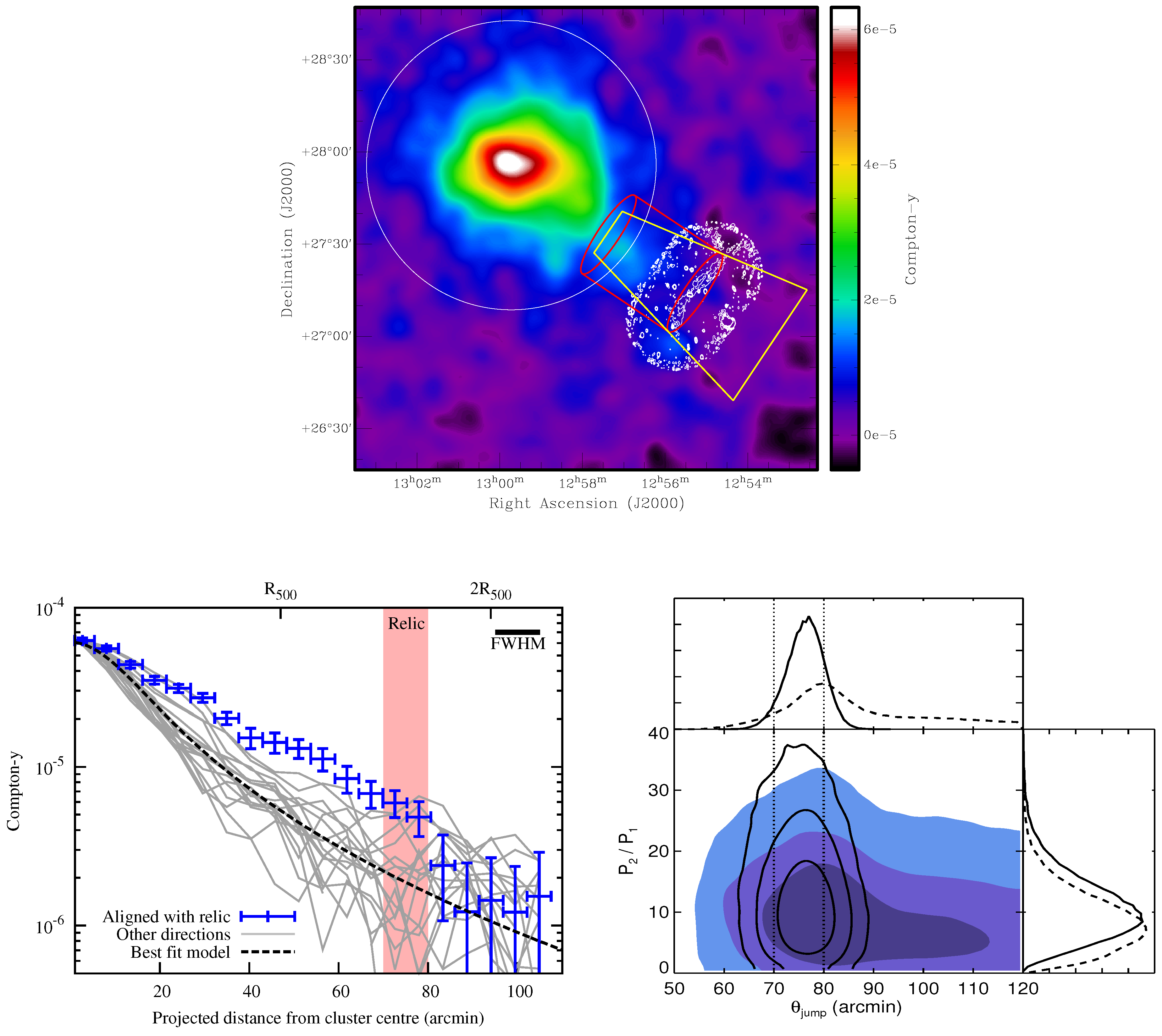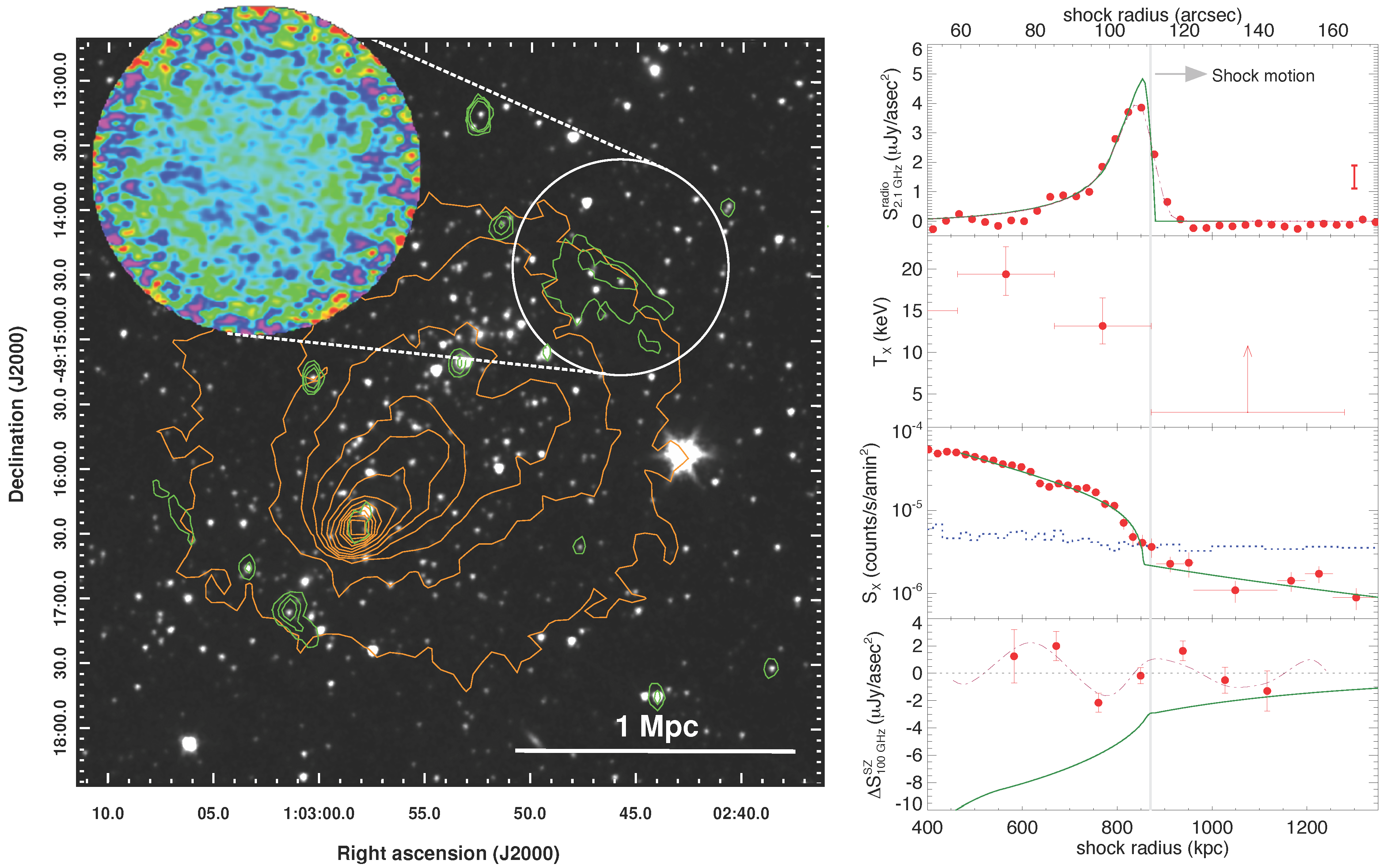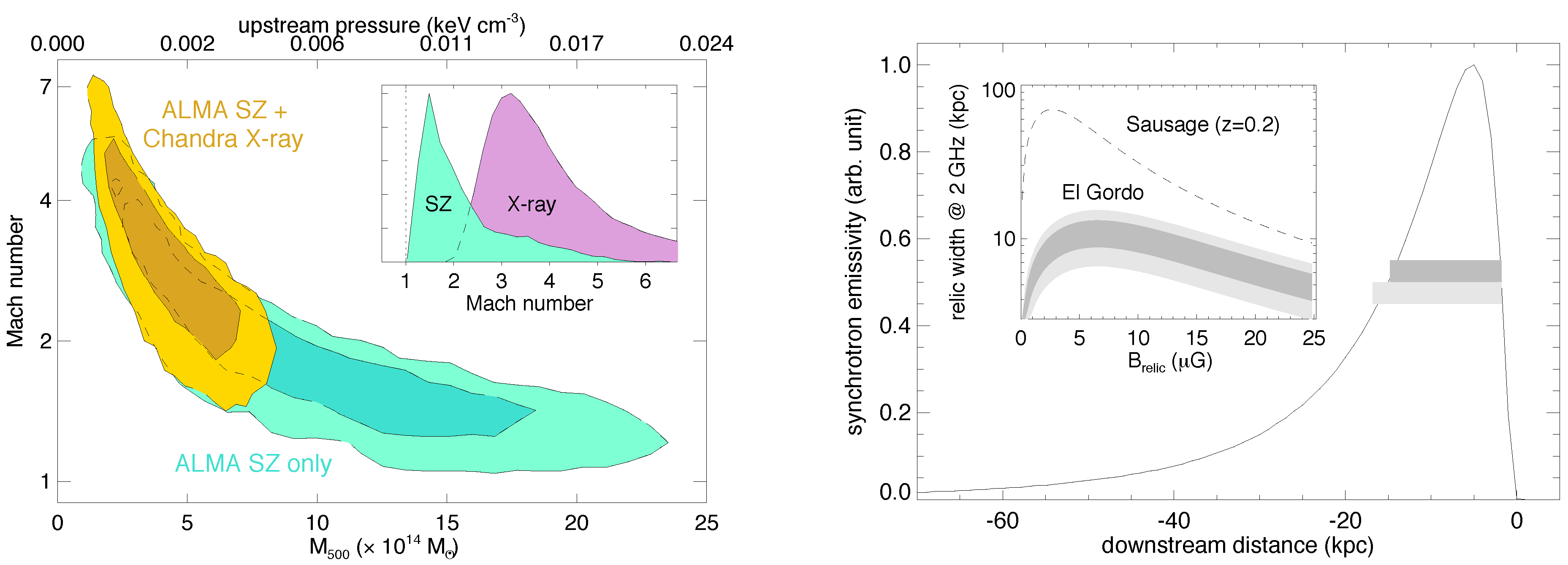1. Introduction: Cluster Outskirts as Revealed by Shocks
Despite the oft-quoted phrase of galaxy clusters being the largest virialized objects in the universe, at no stage of their evolution are galaxy clusters truly isolated systems. In addition to a continuous matter accretion taking place at the outer boundaries, clusters grow in mass through dramatic merger events which generate low Mach-number shocks in the hot intracluster medium (ICM). These shocks, with typical Mach number values in the range 2–4, produce sharp jumps in the density and temperature fields of the ICM, and also energize a population of GeV-energy electrons through the first-order Fermi acceleration process (e.g., [
1,
2,
3]). In the rare cases when the merger happens roughly in the plane of the sky, the surface brightness discontinuities become easy to observe and to model. Radio synchrotron emission from cluster shock fronts viewed roughly edge-on are known as radio relics, and are typically observed in the cluster outskirts (e.g., review by [
4]). Therefore, performing follow-up observations of radio relics in several other wavebands and carrying out a comprehensive shock modeling can be a useful method to learn about the physical conditions in the galaxy cluster outskirts.
The connection between merger shocks and the galaxy cluster radio relics has been established through numerous theoretical works (e.g., [
5,
6,
7,
8,
9]). Until recently, the observational evidence followed mainly from X-ray data (e.g., [
10,
11,
12,
13]), but now powerful millimeter/ sub-millimeter instruments like the MUSTANG/GBT, NIKA/IRAM, and in particular, ALMA are ready to provide resolved images of galaxy cluster merger shocks through the Sunyaev–Zel’dovich (SZ) effect (see [
14] for the first SZ shock result in MACS J0744.8+3927). We have made the first SZ shock measurements for radio relics in the cluster outskirts: for both the nearest radio relic cluster (Coma) using
Planck data [
15], and also for the most distant radio relic cluster (ACT-CL J0102−4915, or “El Gordo”) using ALMA data [
16]. In this conference proceeding article, we briefly review these results to illustrate how the joint modeling of the thermal (SZ effect and X-ray) and the non-thermal (radio synchrotron) signals can provide a consistent picture of the shock Mach number and the physical conditions of the ICM in the cluster outskirts. First, however, we start by describing how the SZ effect can potentially influence the relic flux measurements at GHz frequencies (1–30 GHz), giving the impression of a rapidly steepening synchrotron spectrum [
17].
2. Relic Shocks as Seen in Radio Synchrotron and the SZ Effect
A direct consequence of having a shock for producing a radio relic is that there should be an associated boost in the ambient thermal pressure of the ICM, just like the boost in the ICM density and temperature that has been observed in the X-ray. This boost would then be visible in the SZ effect, which measures the line of sight integral of the gas thermal pressure. Since the pressure boost roughly scales as Mach number squared, one can easily produce an order of magnitude increase for a
shock. Thus, even though the low ambient pressure in the cluster outskirts is currently difficult to measure from the SZ effect, this shock-related boost should be easily observable. Moreover, at GHz frequencies, the steeply falling synchrotron spectrum will lead to a situation where the negative shock-boosted SZ signal amplitude will become comparable to the positive synchrotron flux. A steepening of the relic spectrum has recently been observed in the famous “Sausage” relic in the CIZA J2248.8+5301 cluster, and the “Toothbrush” relic in 1RXS J0603.3+4214 [
18,
19]. This has resulted in various theoretical speculations attempting to explain the steepening, which are based on non-standard extensions of the diffusive shock acceleration (DSA) paradigm [
20,
21,
22]. Our proposed explanation [
17] is a simple consequence of the relic shock hypothesis, and while the SZ effect may not be the only contributor to the observed spectral steepening, it can be the dominant effect and should be easy to account for.
In
Figure 1 (left), we show a simplified model of how at GHz frequencies the radio synchrotron and the SZ effect signals may look at the position of a radio relic. The shock is assumed to have a Mach number
at the radius of one Mpc from the center of a typically massive cluster. The SZ effect causes a negative signal boost of roughly the same spatial scale as the radio synchrotron emission. In
Figure 1 (right), the impact of this flux contamination is shown for fiducial relic spectra with different Mach numbers. The relative effect is stronger at lower Mach numbers, where the synchrotron spectrum is steeper. In
Figure 2, we demonstrate that since the SZ signal variation occurs roughly at the same length scale as the relic synchrotron emission, interferometric measurements trying to obtain the GHz-frequency relic fluxes will not be immune to SZ flux contamination, even though the global SZ signal from the cluster itself will be almost completely filtered out.
We showed in [
17] that the flux contamination can be from a few percent to over 80% in the frequency range of 10–20 GHz for several well-known cluster relics. For the measured flux values in the Sausage and Toothbrush relics, this simple model provides an adequate fit (
Figure 3). In the Sausage relic, the 16 GHz data point appears to be low in comparison to the models, but still within the range of a steep spectrum synchrotron emission (
). A similarly low Mach number for the Sausage relic shock is actually inferred from the X-ray observations [
12]. We also note that a steep spectrum is not a necessary condition for the SZ contamination to be of significance; in these examples, it is suggested that way because we are trying to fit the full relic spectrum with a single power-law model. The difficulty of fitting the low-frequency part with a single power-law for these relics is well known, and in reality, the shock fronts can have a distribution of Mach numbers (e.g., [
8]). Our goal is to show that the SZ flux contamination is non-negligible and can even be the dominant effect behind the observed spectral steepening of radio relics at GHz frequencies. This hypothesis can furthermore lead to new methods for testing the relic-shock connection and putting constraints on the relic magnetic field or the shock acceleration efficiency (see [
17]).
3. The First SZ Effect Measurement of a Relic Shock
We have discussed the potential impact of the SZ effect in measuring radio relic fluxes at GHz-frequencies, but are these hypothesized pressure boosts from the relic shocks actually observable? For answers, we turn to direct SZ measurements of radio relics at 100 GHz or above (at these frequencies, synchrotron contamination to the SZ signal similar to what we discussed in
Section 2 can be safely ignored). Our work reported on the first SZ measurement of a relic shock, by making use of the publicly available
Planck data, at the location of the Coma cluster relic [
15]. This Coma relic shock had been measured previously in the X-ray, using
XMM-Newton and
Suzaku data [
12,
13], but a debate persisted on whether it is an infall shock caused by accreting materials, or a merger shock originating from the core region of the Coma from a past merger [
13,
23]. Our measurements show clear preference for the merger shock scenario.
The work presented in [
15] was based on a Comptonization map (or
y-map) extracted from the 15-month nominal
Planck mission data, and we additionally made use of a high-resolution 2.3 GHz radio measurement of the Coma relic to set a prior on the shock location. The
Planck SZ image is shown in
Figure 4 (top), along with the radio contours for the relic at 2.3 GHz. The SZ profile in the direction of the shock propagation is shown in the lower-left panel, in comparison to profiles from other radial directions. The apparent significance of the
y-jump is not high; nevertheless,
Planck data give clear evidence for a shock (
from a cylindrical shock model). This result is corroborated when the final (2015) data release from
Planck is used; for example, using a spherical geometry as is common in cluster shock modeling, we obtained
[
17], which is fully consistent with the original results from [
15]. Models based on an infall shock or a pressure excess associated with a sub-cluster are ruled out when
Planck results are combined with X-ray measurements. Importantly,
Planck data alone show evidence for a pressure jump in the Coma relic without any additional radio or X-ray priors (
Figure 4 lower-right), thus making it an independent confirmation of the existence of a shock.
4. ALMA-SZ Measurements of a Relic Shock
Using
Planck y-maps with roughly
resolution is clearly not the optimal method for measuring relic shocks; nevertheless, it was made possible thanks to the proximity of the Coma cluster. As the X-ray observations evolved from
Uhuru to
Chandra to provide excellent spectral-imaging measurements of shock fronts in several galaxy clusters, the SZ effect now has a similarly powerful instrument in ALMA, to make arcsecond resolution images of shock fronts in the millimeter/sub-millimeter wavebands. We have recently reported the first measurement of a cluster merger shock with ALMA [
16], which is also one the first ALMA results on galaxy cluster SZ effect in general. The target was the highest redshift radio relic currently known, in the famous El Gordo cluster at
[
24,
25], in a clear demonstration of the power of the SZ effect to make resolved cluster images with equal efficiency at all redshifts.
The small field of view of ALMA at 100 GHz (primary beam FWHM
) allows for the imaging of only a limited sector of a galaxy cluster with a single pointing, but the angular resolution (in a compact array configuration) is roughly
and unparalleled for SZ observations. Our observation of the prominent NW relic in the El Gordo cluster using a brief 3 hr ALMA exposure is depicted in
Figure 5 (left panel). The background image is a mosaic of
Spitzer IRAC pointings at 3.6 µm, and the colored contours show the soft-band X-ray (from
Chandra: in orange) and 2.1 GHz radio synchrotron (from Australia Telescope Compact array: in green) emissions. With ALMA, we were able to clearly detect the signature of an underlying pressure discontinuity from an observed modulation of the SZ signal, as shown by the deconvolved image (or dirty image) in the inset. The shock modeling was not based on this image, however, but used a novel Markov chain Monte Carlo fitting technique directly applied to the visibility data (or
-data) in order to avoid imaging biases. This Bayesian method also enables an easy combination of results from the X-ray and radio wavebands.
The ALMA SZ data provides evidence for a shock whose amplitude and location is consistent with the radio and X-ray measurements, as shown in
Figure 5 (right panel). This is the first instance where the thermal and non-thermal signal variations are modeled self-consistently across a relic shock based on the same underlying shock geometry. The
Chandra exposure totals roughly 100 hr (350 ks), but even with that deep data, the outer (pre-shock) region’s temperature cannot be constrained for this high-
z object. SZ measurements can thus be an indispensable tool to robustly constrain the shock Mach numbers from many high-
z radio relics, soon to be discovered from multiple upcoming radio surveys. More broadly, joint SZ/X-ray analysis combining high-resolution SZ observations with short-exposure X-ray data—where the latter would provide constraints on the gas density but not necessarily its temperature—can be an efficient and wide-ranging tool for modeling the shock velocities and physical conditions in the pre-shock medium.
Two present examples of joint SZ/X-ray modeling (also in combination with radio synchrotron data) are shown in
Figure 6. In the left panel, we illustrate the Mach number constraints. SZ/X-ray joint fit suggests a similar Mach number value as in a previous radio spectral slope analysis [
25], but there is a mild tension between the individual X-ray and SZ measurements, as shown in the left panel inset. ALMA SZ modeling by itself points towards a weak shock, with peak likelihood for the Mach number around
, whereas the X-ray brightness modeling supports a strong shock with
. Although statistically not very significant, we can speculate on some physical effects that can cause a similar difference between the SZ and X-ray Mach number measurements. Such effects can include a possible non-equilibrium between the electron and ion temperatures or a boost in the X-ray brightness from an inverse Compton emission behind the shock front. The mismatch can also be partially due to a projection bias, where the choice of the shock geometry affects the X-ray brightness and the Comptonization profiles differently.
In the right panel of
Figure 6, the magnetic field strength inside the radio relic is constrained from a deprojected synchrotron emissivity profile, making use of an empirical model described in [
17]. The upstream temperature and the shock Mach number are constrained from the SZ/X-ray analysis when calculating the relic width as a function of the magnetic field strength (results shown in the inset of the right panel). The estimated field strength is of the order 4–10 µG, which is unusually high for this redshift. It is possible that part of the observed relic width at 2 GHz comes from a secondary amplification of the particle energies or the magnetic fields [
22,
26].
5. Conclusions
We presented the first SZ measurements of galaxy cluster merger shocks at the location of radio relics. These are also the first SZ-measured shocks in the cluster outskirts. Even though SZ measurements alone cannot provide a complete thermodynamical description of the ICM (i.e., independent density and temperature measurements) as in X-ray imaging/spectral analyses, SZ imaging is clearly adequate for modeling the location, strength, and the geometry of a merger shock. Especially in the cluster outskirts and for high-z objects, SZ measurements should be the preferred tool, as it scales linearly with the gas density and its surface brightness is redshift independent. For a complete thermodynamical description of the pre-shock medium and an estimation of the shock velocities, joint SZ/X-ray analysis combining short-exposure X-ray and SZ data can be far more efficient than deep X-ray observations alone. For radio observers, we have shown that the SZ effect can act as an effective contaminant to the synchrotron flux measurements at GHz frequencies (1–30 GHz), lowering the measured fluxes and giving the impression of a steepening synchrotron spectrum. However, far from being a simple nuisance for relic measurements, this SZ flux modification can potentially offer some of the best evidence for the relic-shock connection, and under certain assumptions can provide an independent method for estimating the relic magnetic field or the shock acceleration efficiency.











